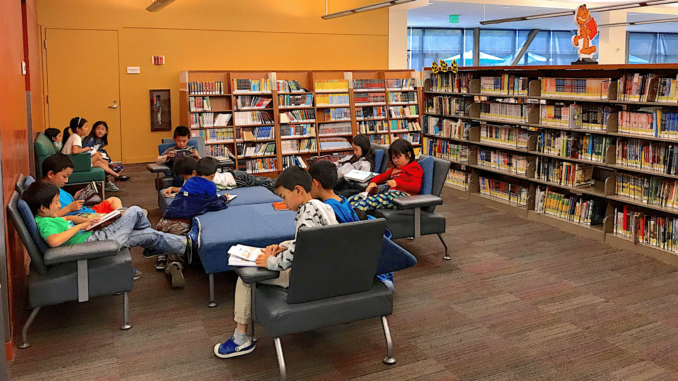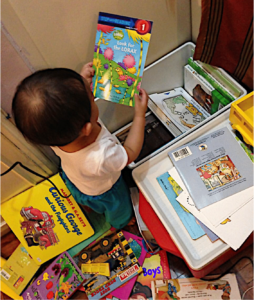
In 2011, Education Secretary Lasallian Brother Armin Luistro declared every November a National Reading Month aligned with then Pres. Benigno Aquino’s Every Child A Reader program.
The literacy program had simple goals: a read-a-thon to celebrate outstanding readers; daily 15-20 minute reading time; older students help younger readers; remedial reading classes; students learn a new word and read a paragraph daily; and one hour of library time weekly.
This is a step in the right direction. Br. Luistro knew that promoting literacy would prepare our future workers to be globally competitive.

Yet this month, there is no sign that the Department of Education will continue this program. Its website doesn’t mention it and it has not responded to my e-mail queries. DepEd needs to get with the program. Strengthening literacy throughout the school years has the greatest impact on a child’s ability to be self-sufficient and contribute to a nation’s productivity.
Literacy is the foundation of all learning because it develops memory, comprehension, communication, analysis, and imagination—cognitive skills critical for innovation. It is so important that leading industrialized nations with the strongest GDP make it a priority for all their citizens.
“Literacy—the ability to access, evaluate, and integrate information from a wide range of textual sources—is a prerequisite not only for individual educational success but for upward mobility both socially and economically.” (Sean F. Reardon, Rachel A. Valentino, and Kenneth A. Shores)
Literacy has a multiplier effect because it empowers people, enables them to participate fully in society, and increases livelihoods. It drives sustainable development since literate people can find work; improve their family’s health and nutrition; expand their life opportunities; and reduce poverty. (UNESCO)
“Beyond its conventional concept as a set of reading, writing and counting skills, literacy is now understood as a means of identification, understanding, interpretation, creation, and communication in an increasingly digital, text-mediated, information-rich and fast-changing world.” (UNESCO)
I hope you comprehend
Despite scarce public libraries, expensive books, and inaccessible reading materials, the Philippines has the highest literacy rate (96.4%) compared to Indonesia, Vietnam, China, and India. Literacy is tested as the ability to read and write from age 15. Singapore literary rate is 96.8%.
Like Singapore, Filipinos are strong English speakers. English is the country’s medium of instruction and official government communication. The Philippines ranks second in Asia for English proficiency, next to Singapore. PH used to be third. PH and Singapore are also the top importers of US books in the world.
PH is so close to Singapore’s literacy, English proficiency, and US book imports yet Singapore leaves us behind in achievement scores. Singapore ranks first (2015) and second (2011) in Reading in PISA, a study done by wealthy countries in the OECD. Reading is closely linked to science and math proficiency so Singapore was also first in 2015 PISA for both. PH doesn’t even participate in PISA.
Nearly all of the world’s information online and in print are in English, and Filipinos are strong English readers and speakers. Globally, PH ranks 14th out of 88 nations in English fluency, better than Switzerland and majority of Europe. PH outranks the whole of Latin America, the Middle East, and North Africa. The closest Asian nations are: Malaysia -22; India -28; HK -30; Vietnam -41; China -47; Japan -49; Indonesia -51.
Although English is used for assessment tests, PH trails behind Singapore. Why? Because there are two kinds of literacy. First is the basic ability to sound out and decode a word. That’s what most Filipinos can do. The second is reading for comprehension, which many cannot do after highschool.
“[R]eading for comprehension—integrating background knowledge and contextual information to make sense of a text—requires an additional set of knowledge-based competencies in addition to word-reading skills.” (Reardon et al.)
This means our country has to strengthen our education through increased reading for comprehension. And that begins with books. Lots and lots of good books.
Wherefore art thou biblio?
It’s not enough that Filipinos can read. They have to understand what they read. That involves strong cognitive skills. The best way to develop a skill is to practice. So we need to give Filipinos plenty of books and plenty of time to read so they can keep reading throughout life.
“[I]f newly acquired literacy skills are not constantly used and improved, there is a real danger that those who have acquired literacy skills will relapse into illiteracy and the huge investment in school education and adult literacy classes will be wasted.” (UNESCO)
The Philippines needs to expand the National Reading Month program into a lifetime—from preschool to adulthood. Like China, the PH government needs to strengthen the country’s English literacy to ensure our continued sustainability.

Every reading program should begin with a free book for each student. Public schools should give away books as part of the Reading or English subject. Books can also be given as prizes to students who log the most books or hours read. Academic incentives should include free books instead of useless plaques. All classrooms should be supplied with enough books for each student in a class library.
Primarily, the government should make plenty of books and reading materials accessible for everyone through public libraries. PH libraries total about 1,506 which gives a ratio of 69,700 people per library where an average capacity is about 1,000. These libraries are mostly concentrated in the capital Manila and surrounding cities. With internet penetration only at 55.5%, printed books and periodicals are still the primary source of knowledge and leisure reading for many Filipinos.
But books are pricey in the Philippines. A paperback costs P200 ($4) and a hardcover costs over P537 ($10), which is a day’s minimum wage. Only high-income families can afford to buy their children non-academic books and periodicals for leisure reading. Similarly, funded private schools have the resources to stock a library while public schools do without.
Each public school should have a well-stocked library where students can access newspapers, magazines, publications, reference books, art and science books, technical materials, fiction, and nonfiction. Where there is no internet, the availability of books and periodicals will still enable students to keep abreast of the latest news and information.
It is important to make time for reading. Teachers should read to the young students, while older students should have quiet reading time, all during school hours. Students should continue reading time at home, like during breaks or at bedtime. Just like adults who sit down with a warm drink to read their news in the morning, students should develop the association that reading is for pleasure, not just for knowledge or school. This helps form the habit of lifetime reading.
Businesses and companies should have private libraries available to workers and as part of their continued learning and training. With the rapid technological changes, it is incumbent upon employers to continue to educate their executives and employees for a smarter and more productive workforce.
Bookstores should give students, teachers, and schools discounts on books and reading materials. They can also donate used, returned, or damaged books that are still in readable condition. Story time and book raffles will also encourage families to visit the store.
Churches, charitable organizations, and non-profits can organize book drives to collect book donations and distribute books to needy neighborhoods and schools. If books are available when there is nothing else to do, maybe someone will pick up a book and read.
Individuals and private entities can help bring more books to the public. Many book lovers have shared their libraries with others in their community. There is a global free library movement (https://littlefreelibrary.org) that builds small standalone libraries where anyone can get or give a book anytime.
Filipinos have the English advantage in Asia

“With rapid growth in trade and technology, Asian countries with strong English proficiency are thriving. Singapore, which has consistently scored in the top 10 of the EF EPI, has had a trade to GDP ratio of over 300% since 1960. Although India is better-known for offshore services, it is the Philippines, with less than 10% of India’s population, which has the larger number of call centers.” (EF English Proficiency Index)
Less than 10% of India’s population speak English, and those who do likely have a strong accent. Whereas Filipino call centers easily speak with American accents, which appeal to US companies and multinationals with English-speaking clients and businesses.
It is predicted that China’s tech industry will be at par with the US in 15 years. “China’s transition from a manufacturing economy to a knowledge-based economy requires more people with strong English communication skills.” (EF EPI)
China is 47th out of 88 countries for English proficiency. To become a global market leader, China prioritizes the need to learn English. It aggressively recruits English teachers to come to China and teach at all grade levels, in colleges, and even workers. Wealthy families send their kids to the US or the Philippines to learn English.
With 70% of parents who want their children to learn English, many hire private tutors. “The private English language training market in China is estimated to be growing at 22% per year.” (EF EPI)
But Filipinos already have an advantage because most grow up learning English in school and in the community. Many businesses, TV shows, news, books, and periodicals are in English. While China and India are playing catch up, Filipinos already fluently speak, read, and write in English.

It’s hard to explain our country’s high literacy and English fluency considering the constant attack on our educational system and lack of learning resources. We need to conduct a nationwide survey of schoolchildren to understand where we are deficient or strong. Then we need to study the techniques that work and implement it for all. What we don’t measure, we cannot fully understand.
Nevertheless, we need a consistent literacy program for all Filipinos. Maybe the problem is the lack of sustained reading skill. We need to consistently maintain our English literacy and proficiency throughout the school years and into adulthood.
Studies show that Filipinos who emigrate to industrialized nations like UK, US, and Australia perform excellently in school, sometimes surpassing the native-born citizens. Experts believe that the resources available in the adopted country enhance the Filipino immigrant’s basic English literacy. Since Filipinos can already read and write in English, their access to an excellent education, rich experiences, and plenty of books reinforced their overall literacy.
Globally, Filipino overseas contract workers assimilate well into their new country because of their English proficiency. We can do better than service level work. Filipinos with high literacy have the mental stamina to undertake rigorous training in many high-paying professions like law, medicine, engineering, accounting, business, research, intelligence, and technology.
Filipinos have the resiliency to adapt to the unpredictable changes of the digital age. But we need high-level cognitive and communication skills that cannot be automated. We need a concerted effort from the government, businesses, private sector, church, academia, non-profit organizations, world organizations, and individuals to promote our nation’s literacy. It cannot be a one-shot deal that ends in high school. Fostering literacy is a continuous constant national effort.
“If people are to stay literate, they must have access to a wide variety of written materials and continue the habit of reading in their adult lives.” (UNESCO)
